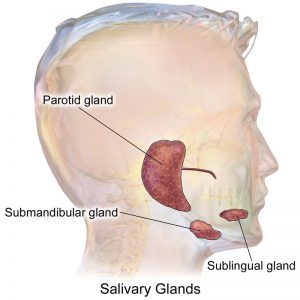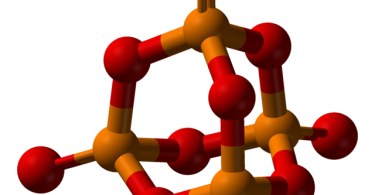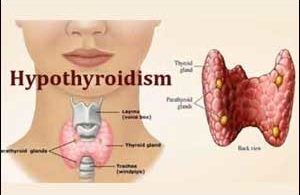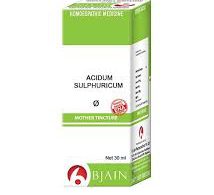 The patient complained of soreness, swelling and throbbing at the floor of the right side of the mouth. The temperature was 101 F. The mouth was exceedingly dry and the mucus surface very red, the sublingual gland had continued to swell until it was about the size of an egg. The general symptoms were those of throbbing headache < jar and motion, even the motion of talking. The dreams were disagreeable, with starting from sleep. On these symptoms, I prescribed Belladonna.
The patient complained of soreness, swelling and throbbing at the floor of the right side of the mouth. The temperature was 101 F. The mouth was exceedingly dry and the mucus surface very red, the sublingual gland had continued to swell until it was about the size of an egg. The general symptoms were those of throbbing headache < jar and motion, even the motion of talking. The dreams were disagreeable, with starting from sleep. On these symptoms, I prescribed Belladonna.
Two days after, the swelling had increased still more; the patient complained of sticking pains in the sublingual region and had broken out into a moist perspiration. The prescription this time was Hepar sulph. The next day, upon examination of the gland, I discovered a white speck on the floor of the mouth which upon touching with a probe, gave out a metallic sound with a pair of forceps. I removed half inch of calcareous matter, perfectly white from the lumen of the canal to the submaxillary (submandibular) gland. This case illustrates the use of complimentary remedies. Belladonna was called for in the acute manifestation, then Hepar sulph which is complimentary to Belladonna. Later Calcarea symptoms developed and Calcarea carb made a complete cure.
This case I have just quoted was that of an adult. Another case, almost identical in the symptom picture and with the same prescriptions and sequence of events, even to the calcareous deposit in the gland canal, occurred in a child of eight years at the same time as the first case quoted. At the end of the acute manifestations, this case also called for the chronic constitutional remedy of Calcarea carb.
Very recently I had two cases of idiopathic inflammation of the parotid gland, where the swelling was very extensive more so than in any case of mumps I have ever seen. The pain was intense at first and the temperature 102oF. In both cases the parotid gland of the right side was effected, with complete tetanus of the jaw which could not be opened at all. The headache was severe throbbing < night < motion and jars, pupils dilated. Belladonna was prescribed. This condition lasted for three days, with practically no sleep because of the intense pain. On the third day when I visited these patients I found both of them with their heads done up in large shawls and they were in a drenching perspiration. Silica was administered and the patients made rapid and uneventful recoveries.
A curious thing about these four cases is that in both instances the two cases showed the same symptoms and practically the same time although not having any relationship to the other in the matter of location nor even being in the same social circles. I have reported these cases as illustrative of very peculiar, a typical infection of the salivary glands. The sublingual glands produce a great deal more mucin, which probably accounts for the despair of calcareous matter from the source; where as the parotid gland secrete very little mucin and therefore the secretion is much more liquid and less liable to crystallization. These four cases illustrate very clearly the sequence of remedies and the complimentary nature of certain remedies. The constitutional remedy is seldom called for in the acute manifestations; but as Hahnemann, Boenninghausen and Kent suggest, the chronic constitutional remedy may very appropriately be administered at the close of a case whereas the complementary remedy will be one to relieve the acute distress.
I have come to the opinion that if we will study our double salts and mineral remedies, these deep acting drugs especially combinations such as Calcarea carb, Calcarea flourica , Calcarea phos and Calcarea sulph and the same way with the Kali group and others, we will get far better and will get far more lasting effect than by just prescribing a single remedy.
I had a case of tubercular nature which I have been treating for about three years, a young married woman about twenty-four or twenty-five years of age. She had beautiful symptoms of Phosphorous. It ameliorated her. She got along fine as I was careful about repeating it on account of the violent action. In my early days of practicing, I repeated Phosphorous in a young man with tubercular symptoms and stepped it up to 10 M potency, result – an acute case of tuberculosis which looked bad. I went to see Dr. Thatcher and he said “the only trouble with you is you have murdered the Marr; he is going to die “. He was very frank and he told the truth, so I was careful in this case of repeating Phosphorous. However, I did repeat it finally, but in a different way. I figured out there were some Calcarea features and also there were phosphorous features. I studied upon Calcarea phos and finally gave powder of 30th potency, that did wonders for her.
The probabilities that Calcarea phos was the true simillimum all the time and I did not see it. I think sometimes we don’t study these double remedies enough. The 12 tissue remedies and similar combinations have tremendous depth of action and are not so violent.





